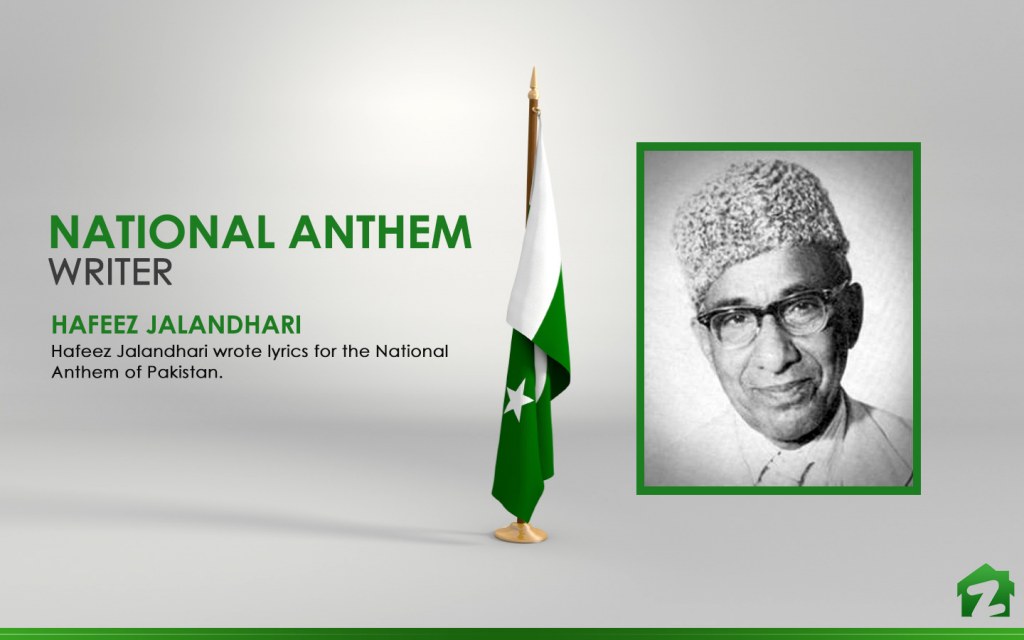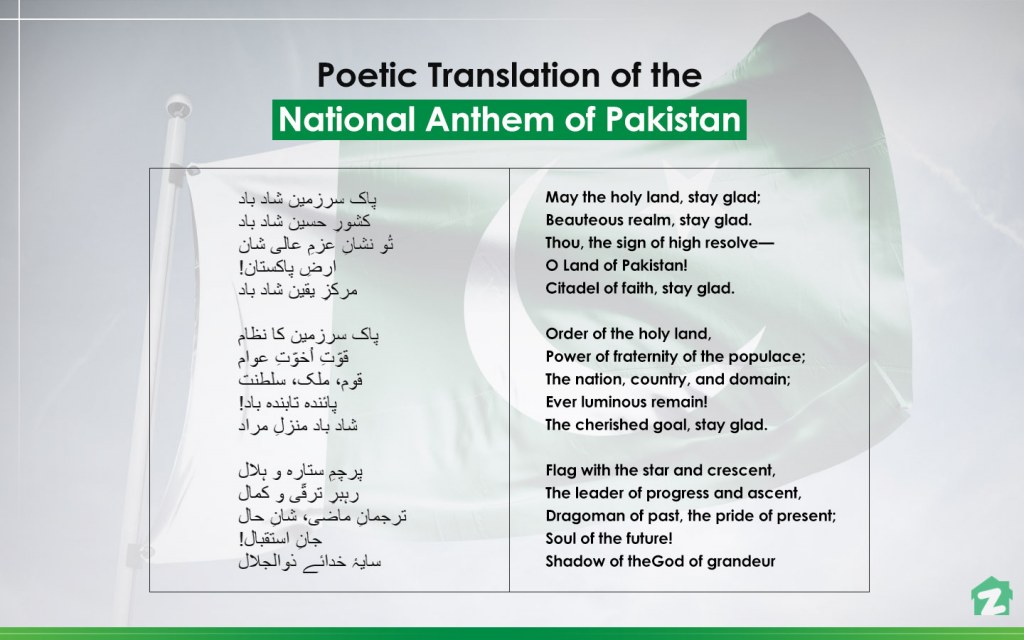Updated: Aug 3, 2022
To mark the 75th anniversary of Pakistan’s independence, the national anthem of the country has been re-recorded with the same lyrics but new voices and expressions. The new version of the national anthem will be released by the Government of Pakistan on the 75th anniversary of Pakistan on August 14, 2022.
The Steering Committee for re-recording was headed by Senator (r) Javed Jabbar and comprised 16 other members out of which 10 served voluntarily, five were senior civil officials and one was senior military official. The audio subcommittee consists of Arshad Mahmud, Brigadier Imran Naqvi (ISPR), Rohail Hyatt, Talha Ali Khushwaha, Ustad Nafees Ahmed, Layaqzada Layaq and Dr. Zulfiqar Qureishi. The convenor of the video sub-committee is Satish Anand.
The re-recorded version of the national anthem reflects new voices and expressions while keeping the sanctity of original words and musical composition intact. While the lyrics are all the same, the vocalists belong to diverse regional, cultural and ethnic backgrounds from all religious faiths and musical genres. Skilled musical bands of the Pakistan Army, Navy and Airforce played the instruments.
In order to sync 155 vocalists and instrument players, every artist was rehearsed and mentored and was given an artist kit which contained lyrics, translations and pronunciation guides. These rehearsals and mentorship played vital roles in maintaining the historic and rich legacy of Pakistan’s National Anthem.
___________________________
Listening to the tune and lyrics of the national anthem of Pakistan evokes the spirit of patriotism among the country’s citizens. This devotion knows no geographical boundaries. It instills a sense of pride in the nation as well as the will to serve and, if need be, die for our beloved country. In this blog, we will discuss how the national anthem of Pakistan was composed and its historical background.
Interesting facts about National Anthem of Pakistan

- Composed by musician Ahmad Ghulam Ali Chagla in 1949
- The national anthem has 21 music instruments and 38 different tones. The time duration is of 80 seconds
- Famous poet Hafeez Jalandhari has written the national anthem.
- A competition to select the best song for Pakistan was held; the prize money offered was PKR 10,000.
- From around 723 songs, the current national anthem of Pakistan was selected
- The entire national anthem of Pakistan has been written in the Persian language
- There is only a single word ‘ka’ of the Urdu language
- Prominent singers namely Najam Ara, Ahmad Rushdi, Kokab Jehan, Naseema Shaheen, Shamim Bano, Rasheeda Begum, Zwar Hussain, Ghulam Dastgir, Akhtar Abbas, Anwar Zaheer, Zwar Hussain and Akhtar Wassi.
- On August 13, 1954, the national anthem was released on Radio Pakistan
- On January 19, 1955, the Pakistani national anthem and flag were presented in the first-ever colour film in the U.S.
History of national anthem of Pakistan
In December 1948, the newly formed government of Pakistan founded the National Anthem Committee (NAC) and gave them the task of composing music and lyrics for the official national anthem of Pakistan. The NAC was chaired by Sheikh Muhammad Ikram, the Information Secretary and the members included several poets, politicians and musicians, including Ahmad Ghulam Ali Chagla, Sardar Abdur Rab Nishtar and Hafeez Jalandhari.
The committee initially struggled to come up with something that did justice to the struggle and sacrifices of the people who led to the birth of the country. Then, in 1950, President Sukarno, the head of state of Indonesia, paid a visit to Pakistan. Unfortunately, Pakistani officials didn’t have a tune they could use to pay homage to their homeland while a foreign leader was in town. This incident called for immediate action and so, when the visit of Shah of Iran was expected, the government of Pakistan urged the NAC to submit the national anthem. Finally, from among hundreds of entries, the tune composed by Ahmad Chagla was selected and officially adopted on August 21, 1950.
When the Shah of Iran visited Pakistan on March 1, 1950, the Qaumi Taranah was played but without any lyrics. Two years later, in 1952, the lyrics written by Hafeez Jalandhari were selected from 723 entries. It was a historical moment when on August 13, 1954 the Qaumi Taranah was first broadcast on Radio Pakistan.

Many years later, in 1996, Junoon, a Pakistani sufi rock band, breathed new life into the composition via an electric guitar. In 2009, Pakistani musician Jehangir Aziz Hayat produced a soulful instrumental rendition that took the world by storm.
Things kept getting bigger and better in the following years. A new world record was set in 2011 for “the most people performing a national anthem simultaneously” by 5, 857 people who congregated at National Stadium in Karachi and sung the Qaumi Taranah.
Unique music of national anthem of Pakistan

Pakistan’s national anthem is a melodious, heart-warming tune, comprising three stanzas of beautiful Persian poetry. The best part is that the composition is a unique blend of the East and the West. Thirty eight different tones and more than twenty musical instruments are used to play the music of national anthem of Pakistan. This balance is a reflection of Ahmed Ghulam Ali Chagla’s background in eastern and western styles of music.
Meaningful lyrics of national anthem of Pakistan

The national anthem evokes feelings of patriotism and a sense of responsibility towards nation-building. It is a proclamation of the fact that Pakistan, while being the citadel of Islam, is a diverse country where people live in unity—under one name, under one banner. It’s all crystal clear in the powerful lyrics of national anthem of Pakistan, which we will now examine in three parts.
Like letters penned to a beloved, the national anthem of Pakistan takes off by addressing the country.
“Pak sarzamin shad bad, Kishwar-i ḥasin shad bad
Tu nishan-i azm-i ali shan, arẓ-i Pakistan!
Markaz-i yaqin shad bad”
The first stanza loosely translates to:
“Blessed be the sacred land, happy be the bounteous realm.
Thou symbol of high resolve, O Land of Pakistan!
Blessed be the citadel of faith”
As the music changes, the focus shifts towards the system that governs Pakistan, ending on a promise that the nation shall always be prosperous.
“Pak Sar Zameen ka Nizaam, quwwat-e-Akhuwwat-e-Awam
Quam, Mulk, Sultanat, paainda Ta Binda Baad,
Shad Baad Manzil-e-Murad”
Translation:
“The order of this sacred land, the might of the unity of the people
May the nation, the country, and the state, shine in everlasting glory!
Blessed be the goal of our ambition.”

The last stanza is all about the national flag of Pakistan; how it’s emblematic of our glorious past, our successful present and equally bright future.
“Parcham-i sitarah o-hilal
Rahbar-i taraqqi o-kamal
Tarjuman-i maẓi, shan-i ḥal
Jan-i istiqbal!
Sayah-yi Khuda-yi Ẕu l-jalal”
This roughly translates as:
“The flag of the crescent and star, leads the way to progress and perfection,
Interpreter of our past, glory of our present, inspiration for our future!
Shade of God, the Glorious and Mighty.”
So, these were some lesser-known facts about the Qaumi Taranah. For more updates, keep visiting the best lifestyle blog in Pakistan. If you have any queries or suggestions, feel free to contact us at blog@zameen.com.



